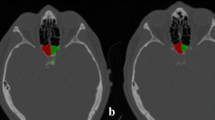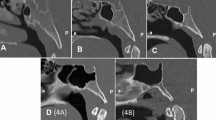Abstract
Purpose
Computed tomography represents the gold standard for the assessment of morphological characteristics of sphenoid sinuses, whose anatomy has acquired a novel interest because of the recent introduction of transsphenoidal surgery and robot-assisted procedures. One of the most relevant parameters for planning surgical intervention is the volume of sphenoid sinuses, and with time few population studies have been published. However, at present, no data are available concerning the relation between volume and anatomical variants of sphenoid sinuses.
Methods
We retrospectively evaluated head CT-scans of 100 patients (age range 25–99 years; mean age males 45.0; mean age females 50.5 years) to calculate the volume of sphenoid sinuses through automatic segmentation. Possible statistically significant differences according to sex and variants of pneumatization, and type of sinus were assessed, respectively, through Student’s t test and one-way ANOVA test (p < 0.05).
Results
Average volume of sphenoid sinuses in males was 10.005 ± 5.101 cm3, in females 7.920 ± 3.176 cm3. Differences according to sex were statistically significant (p < 0.05). Patients with pneumatization of pterygoid processes, dorsum sellae and anterior clinoid processes had a significantly higher volume than unaffected subjects. Moreover, differences of volume according to the type of sphenoid sinus were statistically significant (p < 0.05).
Conclusions
Results show that volume of sphenoid sinuses strongly depend upon the type of sinus and possible pneumatization variants. Moreover, the important of ethnic variability is confirmed.



Similar content being viewed by others
References
Anusha B, Baharudin A, Philip R, Harvinder S, Mohd Shaffie B, Ramiza RR (2015) Anatomical variants of surgically important landmarks in the sphenoid sinus: a radiologic study in Southeast Asian patients. Surg Radiol Anat 37:1183–1190
Bongartz G, Golding SJ, Jurik AG, Leonardi M, Van Persijn van Meerten E, Geleijns J, Jessen KA, Panzer W, Shrimpton PC, Tosi G (1999) European guidelines on quality criteria for computed tomography. Report EUR 16262 https://publications.europa.eu/en/publication-detail/-/publication/d229c9e1-a967–49de-b169-59ee68605f1a/language-en. Accessed 19 Nov 2017
Codari M, Zago M, Guidugli GA, Pucciarelli V, Tartaglia GM, Ottaviani F, Righini S, Sforza C (2016) The nasal septum deviation index (NSDI) based on CBCT data. Dentomaxillofac Radiol 45(2):20150327
Cohen O, Warman M, Fried M, Shoffel-Havakuk H, Adi M, Halperin D, Lahav Y (2017) Volumetric analysis of the maxillary, sphenoid and frontal sinuses: a comparative computerized tomography based study. Auris Nasus Larynx S0385–S8146(16):30403–30405
Hamid O, El Fiky L, Hassan O, Kotn A, El Fiky S (2008) Anatomical variations of the sphenoid sinus and their impact of trans-sphenoid pituitary surgery. Skull Base 18:9–15
Hewidi GH, Omami GM (2008) Anatomical variation of sphenoid sinus and related structures in Libyan population: CT scan study. Libyan J Med 3(3):128–133
Yonetsu K, Watanabe M, Nakamura T (2000) Age-related expansion and reduction in aeration of the sphenoid sinus: volume assessment by helical CT scanning. AJNR 21:179–182
Yushkevich PA, Piven J, Hazlett HC, Smith RG, Ho S, Gee JC, Gerig G (2006) User-guided 3D active contour segmentation of anatomical structures: significantly improved efficiency and reliability. Neuroimage 31:1116–1128
Kawarai Y, Fukushima K, Ogawa T, Nishizaki K, Gunduz M, Fujimoto M, Masuda Y (1999) Volume quantification of healthy paranasal cavity by three-dimensional CT imaging. Acta Otolaryngol Stockh 540(5):107–116
Kim J, Song SW, Cho JH, Chang KH, Jun BC (2010) Comparative study of the pneumatization of the mastoid air cells and paranasal sinuses using three-dimensional reconstruction of computed tomography scans. Surg Radiol Anat 32:593–599
Lee DH, Shin JH, Lee DC (2012) Three-dimensional morphometric analysis of paranasal sinuses and mastoid air cell system using computed tomography in pediatric population. Int J Pediatr Otorhinolaringol 76:1642–1646
Lu Y, Pan J, Qi S, Shi J, Zhang X, Wu K (2011) Pneumatization of the sphenoid sinus in Chinese: the differences from Caucasian and its application in the extended transshenoidal approach. J Anat 219:132–142
Oliveira JM, Alonso MB, de Sousa E, Tucunduva MJ, Fuziy A, Scocate AC, Costa AL (2016) Volumetric study of sphenoid sinuses: anatomical analysis in helical computed tomography. Surg Radiol Anat 39(4):367–374
Park IH, Song JS, Choi H, Kim TH, Hoon S, Lee SH, Lee HM (2010) Volumetric study in the development of paranasal sinuses by CT imaging in Asian: a pilot study. Int J Pediatr Otorhinolaryngol 274:1347–1350
Perez-Pinas I, Sabatè J, Carmona A, Catalina-Herrera CJ, Jimenez-Castellanos J (2000) Anatomical variations in the human paranasal region studied by CT. J Anat 197(2):221–227
Pirner S, Tingelhoff K, Wagner T, Westphal R, Rilk M, Wahl FM, Bootz F, Eichhorn KW (2009) CT-based manual segmentation and evaluation of paranasal sinuses. Eur Arch Otorhinolaryngol 266:507–518
Rahmati A, Ghafari R, Anjom Shoa MA (2016) Normal variations of sphenoid sinus and the adjacent structures detected in cone beam computed tomography. J Dent Shiraz Univ Med Sci 17(1):32–37
Sanchez-Fernandez JM, Anta Escuredo JA, Sanchez Del Rey A, Santaolalla Montoya F (2000) Morphometric study of the paranasal sinuses in normal and pathological conditions. Acta Otolaryngol 120(2):273–278
Schumacher GH, Heyne HJ, Fanghänel R (1972) Anatomy of the human paranasal sinuses. 2. Volumetric measurement. Anat Anz 130(1):143–157
Selcuk OT, Erol B, Renda L, Osma U, Eyigor H, Gunsoy B, Yagci B, Yilmaz D (2015) Do altitude and climate affect paranasal sinus volume? J Cranio Maxillofac Surg 43:1059–1064
Sirikci A, Bayazit YA, Bayram M, Mumbuc S, Gungor K, Kanlikama M (2000) Variations of sphenoid and related structures. Eur Radiol 10(5):844–848
Simmen D, Schuknecht B (1997) Computerized tomography of paranasal sinuses—a preoperative check list. Laryngorhinootologie 76:8–13
Stokovic N, Trkulja V, Dumic-Cule I, Cukovic-Bagic I, Lauc T, Vukicevic S, Grgurevic L (2016) Sphenoid sinus types, dimensions and relationship with surrounding structures. Ann Anat 203:69–76
Tingelhoff K, Moral AI, Kunkel ME, Rilk M, Wagner I, Eichhorn KG, Wahl FM, Bootz F (2007) Comparison between manual and semi-automatic segmentation of nasal cavity and paranasal sinuses from CT images. Conf Proc IEEE Eng Med Biol Soc 2007:5505–5508
Uchida Y, Goto M, Katsuki T, Akiyoshi (1998) A cadaveric study of maxillary sinus size as an aid in bone grafting of the maxillary sinus floor. J Oral Maxillofac Surg 56(10):1158–1163
Author information
Authors and Affiliations
Corresponding author
Ethics declarations
Conflict of interest
The authors declare that they have no competing interests.
Rights and permissions
About this article
Cite this article
Gibelli, D., Cellina, M., Gibelli, S. et al. Volumetric assessment of sphenoid sinuses through segmentation on CT scan. Surg Radiol Anat 40, 193–198 (2018). https://doi.org/10.1007/s00276-017-1949-1
Received:
Accepted:
Published:
Issue Date:
DOI: https://doi.org/10.1007/s00276-017-1949-1




